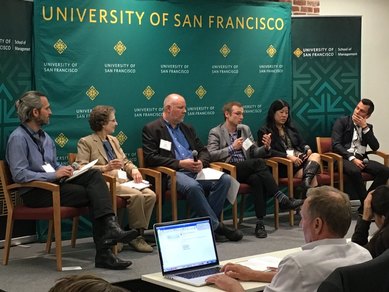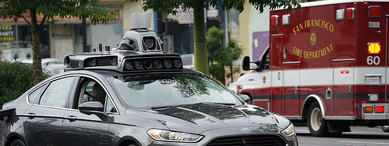Autonomous Vehicles and the City: The urgent need for human- and health-centric policies
I recently served as a panelist for a symposium hosted by the University of San Francisco (USF), emphasizing policies and plans for livability in response to the promise and threat of an autonomous future. The group’s discussion focused on three key areas requiring proactive policy responses: 1) land use, development and design, 2) access, social and environmental implications, and 3) economics, real estate and finance.
Our conversation touched on the transformative technological implications of autonomous vehicles (AVs). However, unlike most of the discussions on this topic to date, the focus was on the current gap in policy and regulatory mechanisms in our communities. Among our multidisciplinary group of policymakers, advocates, planners, designers and engineers, there was a sense of urgency to ensure that we define what our cities should be first, so we can get ahead of and dictate how rapidly changing mobility technologies can support and lead to those desired outcomes.
The stakes are high, with potential implications for utopian and dystopian futures. The opportunities are significant: improved transportation sharing, better use of limited land resources, safer streets, and a transit-focused future. But the risks are even greater: more driving, incentivized sprawl, compromised security, and inequitable application and access.
While growing numbers of AVs will start to populate our roads over the next few years, there will be a mix of AVs and traditional vehicles for decades to come. While a transition to primarily AVs will occur differently in different regions, there is still the need for unifying policies. Rather than allow for an “evolutionary” adaptation to AVs, we must set policies that frame and incentivize a quicker “revolutionary” transition that is driven by cities, not by automobile and technology companies.
USF School of Management faculty member/planner William Riggs chaired the event with Michael Boswell from Cal Poly San Louis Obispo. Melissa Ruhl provided opening remarks and set the stage for a city-centered dialogue by emphasizing the following principles:
- Pricing is the key. We must set rules now for pay-as-you-go and pay-how-you-go, accounting for congestion, surge, and land-use implications, as well as equitable access.
- Public transportation must evolve in conjunction with AVs. We must advance new technologies, emphasize new partnerships, and even consider transit agencies as mobility brokers.
- Our streets need to be redesigned now. We must design our streets to encourage the kind of future we want, facilitate a more rapid transition to the desired mode splits, and account for changing curb demand and parking implications as this transition occurs.
Building upon this framework, we must go even further. City streets represent significant, publically held real estate assets. When we add space currently occupied by parking to these assets, the proportion of our cities dedicated to movement and storage of personal vehicles in relation to density is nothing sort of astonishing. We cannot afford to wait and see what will happen to these assets as vehicle technology rapidly changes. Cities like New York are already considering strategies that prioritize dedicated street real estate for privately-owned AVs, which as numerous mobility experts point out, would take us down the same car-centered design road of the past.
Perhaps the most significant short-term benefits of new technology, ride sharing and on-demand transport, are already here thanks to transportation network companies (TNCs) including Uber, Lyft and others. As we embrace the transportation access economy, we also need to continue to incentivize shared platforms, remove parking minimum requirements from our zoning codes, rethink the value of our street and parking assets, and redesign our streets from the right-of-way line in rather than the center line out. We must demand that our street and parking assets serve people and neighborhoods first, considering the whole picture and systematic implications of our decisions.
Foremost on this list of public service benefits should be human health. Our street real estate must be designed to emphasize the kind of social, physical and individual environments that positively impact the social determinants of health. From dense urban cores to suburban environments, our health-centric approach to city building must demand and prioritize the following outcomes, accounting for nuanced regional differences and local priorities:
- Improved public safety
- Accessible spaces for fitness, physical activity and exercise
- Improved air and water quality
- Integrated stormwater treatment
- Mitigation of climate change
- Habitat protection and creation
- Spaces of respite for improved mental health
- Community identity and placemaking
- Enhanced opportunities for social interaction
- Emergency preparedness and resiliency
As we reframe our street and parking resources in the context of city-wide health metrics, let’s make sure our policies are flexible enough to achieve these desired outcomes while embracing changing technologies. Critical and aspirational conversations like the one convened at USF must become more prevalent and occur more often. And they need to happen now. Let’s continue to pull back the curtain, debunk myths about driverless utopias, and have honest, open and meaningful dialogue within our communities and across multiple planning and design disciplines.
One of the key takeaways from our daylong sessions at USF was that we need to make sure we don’t just talk, but act. What do we want our cities to be moving forward? What will we commit to accomplishing immediately, and in the next six months, and in the next six months after that? Now is the time to plan and act, so that we drive our autonomous future instead of letting it drive us.

